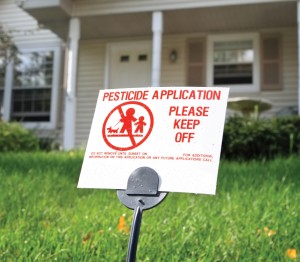
The Problem with Lawns & Pesticides
As communities expand, land-use turns into lawns. Unfortunately, the use of synthetic lawn care products leads to the pollution of our waterways through runoff and negative impacts on the health of people, pets and wildlife. Many people do not realize that homeowners apply up to 10 times more chemical pesticides to lawn turf per acre than farmers use on crops.
Many commonly-used pesticides are harmful to people and the environment. Here are some facts about the harmful effects of commonly-sold products:
1. Human Health: Research has linked insecticides, herbicides and other pesticides to various cancers, asthma and birth defects. Also, studies have linked these chemicals to various neurological, behavioral, reproductive, hormonal and immune system disorders. The International Agency for Research on Cancer classifies roughly 40 chemicals serving as active ingredients in household pesticides as “known, probable, or possible human carcinogens.”
2. Water: A U.S. Geological Survey report found pesticides in 96% of all fish, 100% of all surface waters and 33% of major aquifers studied. We know that lawns and gardens contribute to this widespread pollution as urban watersheds have higher rates of pesticide contamination than any other type of watershed, including agricultural. Keeping pesticides out of our waterways is important as they degrade water quality. A more recent USGS study found evidence of neonicotinoids, a class of insecticides commonly associated with the reduction in honey bee populations, in over 75% of water samples taken from 9 Midwestern streams tested.
3. Aquatic life: Conventional, synthetic and fast-release fertilizers quickly wash into waterways, degrading water quality and creating “dead zones” by promoting excessive growth of aquatic vegetation, which steals the oxygen in the water from other organisms.
4. Wildlife: Pesticides are toxic chemicals used to control pests, but their use can have unintended consequences. Many pesticides are non-specific and can kill or injure non-target species. Birds, amphibians and beneficial pollinators such as honey bees may be affected. Dozens of studies have linked the use of pesticides such as neonicotinoids to declining bee populations, which pollinate many essential food crops.
5. Children: A study by the American Academy of Pediatrics raised concerns about the link between pesticide exposure and childhood cancer, impaired neurological development, asthma and endocrine disruption. The Academy stated that “the most comprehensive reviews of the existing literature implicate an association of pesticides with leukemia and brain tumors.” Studies also suggest that ADHD and other neurological disorders may be related to a disruption in biological systems caused by some pesticides.
